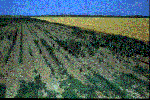 |
Sorghum growth in the central portion of this field is poor because
of sodic soil conditions. Sodic soils lack high concentrations of
soluble salts but have problems associated with high sodium concentrations.
These soils usually have unsatisfactory physical conditions because
of the dispersing influence of sodium.
|
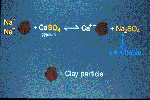 |
Sodium affected soils can also be reclaimed for agriculture for
leaching, with an important additional step. The sodium on the soil
exchange complex must be replaced with calcium. One way to accomplish
this is by applying gypsum to the soil. The calcium in the gypsum
replaces the sodium on the soil exchange complex forming sodium
sulfate which can be leached from the rooting zone.
|
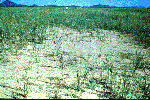 |
Sudan grass is being grown in this field with saline-sodic soil
conditions. Saline-sodic soils have chemical properties of both
saline and sodic soils. The exchangeable sodium percentage is greater
than in saline soils while soluble salt concentrations remain high.
Reclamation of saline-sodic soils requires that the amount of exchangeable
sodium be decreased and excess salts be removed before satisfactory
crop growth is realized.
|
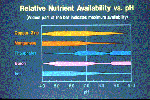 |
Many Aridisols have high soil pH's. Soil pH directly influences
the availability of essential plant nutrients such as phosphorus,
zinc and iron. In this illustration, nutrient availability is plotted
against pH. The wider the bar, the greater the availability. Notice
how the availability of iron decreases as soil pH rises.
|
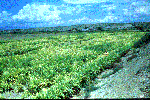 |
The yellowish color of the sorghum grown in this field with calcareous
soil conditions is the result of iron deficiency. The addition of
sulfur and sulfur compounds helps to lower soil pH and increase
the availability of micronutrient elements. In some situations,
micronutrient deficiencies may also be remedied by foliar fertilization.
|

